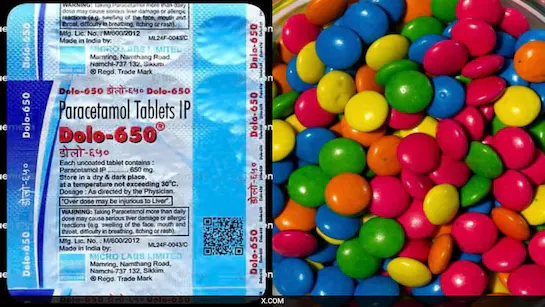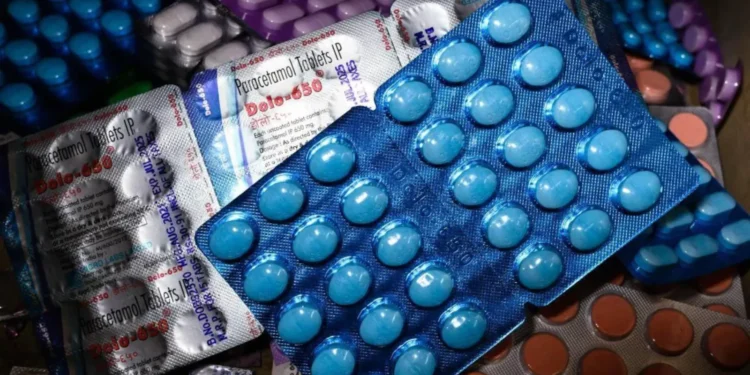Indians: Dolo 650 has emerged as a household essential in India, with its usage seeing a significant surge since the onset of the Covid-19 pandemic. This trusted medication has become a go-to remedy for many, playing a key role in managing fever and pain during challenging times.
Paracetamol: A Silent Addiction
Paracetamol is a staple in every household’s first aid kit, often our go-to solution for everything from fevers and body aches to headaches, sinus issues, cold symptoms, and vaccine-induced discomfort. It has become the everyday shield we rely on, so much so that it’s almost like an automatic fix for any kind of pain. However, what many don’t realize is that this seemingly harmless pill can pose serious health risks if used irresponsibly.
A recent tweet by Dr. Palaniappan Manickam, a US-based gastroenterologist popularly known as Dr. Pal, sparked a viral conversation. He pointed out, “Take 650 like it’s Cadbury Gems.” Dolo 650, a popular brand name for paracetamol, has become so common that it’s often taken casually, much like a vitamin or supplement.
Dr. Rakesh Gupta, a senior consultant in internal medicine at Indraprastha Apollo Hospital, New Delhi, emphasizes the importance of understanding the potential dangers of overuse. “Paracetamol, like any other drug, comes with its own set of advisories. Unfortunately, these warnings are often ignored, leading people to take it without consulting a doctor. The pill is available easily over the counter, which creates a false sense of safety,” he explains.
While it may seem harmless, taking paracetamol in excess can be extremely harmful. Overuse of the drug can lead to toxicity in key organs like the liver and kidneys, potentially resulting in severe health complications.
It’s time we rethink our approach to paracetamol. Just because it’s easily accessible doesn’t mean it’s without risks. Always seek professional advice when in doubt and be mindful of the correct dosage. Don’t let a simple pill turn into a dangerous habit.

Take Paracetamol: A Guide
Paracetamol is a widely used medication for reducing fever and alleviating pain. However, it’s essential to use it correctly to ensure its effectiveness and safety. While paracetamol is generally safe, it should always be taken as prescribed by your doctor. Self-medicating or relying on a pharmacist’s recommendation without proper consultation can be risky, a practice that’s quite common in India but should be avoided.
Paracetamol is available in various forms, including tablets (500 mg, 650 mg, and even 1000 mg) and injectables. It’s important to note that paracetamol is not an anti-inflammatory drug, so it doesn’t help with inflammation, despite its effectiveness in managing fever and pain.
The maximum recommended dose of paracetamol for an adult is 4 grams (or 4000 mg) per day. Exceeding this limit can lead to serious liver damage or other health complications, so it’s crucial to adhere to the prescribed dosage and never exceed the daily limit.
If you’ve been prescribed a 500 mg tablet, you can take up to eight tablets within 24 hours, spaced out approximately every four hours. Allow up to an hour for the tablet to take effect and monitor your condition for improvement.
It is crucial not to combine paracetamol with other medicines that also contain paracetamol, as this could lead to an overdose. Always check the labels of any additional medications you are taking to avoid this risk.
Additionally, paracetamol is generally considered safe for use during pregnancy and breastfeeding, but only when recommended by your healthcare provider. Always follow your doctor’s guidance to ensure the best care for you and your baby.
What Happens in Case of a Paracetamol Overdose? Indians
Taking an excessive amount of paracetamol can have serious consequences, especially for the liver. The liver is responsible for processing paracetamol, but in the case of an overdose, it becomes overwhelmed and produces toxic byproducts. These toxic substances can bind to liver cells, causing significant damage and, in severe cases, leading to liver cell death (necrosis).
In rare cases, affecting around 1-2% of users who exceed the recommended dosage, the liver is unable to neutralize these toxins effectively. As a result, these toxins can also affect the kidneys, causing renal toxicity and impairing their ability to filter waste. Additionally, bleeding may occur in some instances.
It is essential to be cautious with the dosage of paracetamol and seek immediate medical attention if an overdose is suspected to avoid potentially life-threatening complications.
In 2021, England and Wales reported 227 deaths due to paracetamol overdoses, a number that increased to 261 in 2022. If your liver and kidneys are already compromised, or if you regularly consume more than 14 units of alcohol per week, the effects of paracetamol overdose could be even more dangerous. It’s crucial to be aware of the risks and take necessary precautions when using medication, especially if you have pre-existing health conditions.
How Long Should You Use Paracetamol on Your Own?
It’s generally recommended not to use paracetamol for more than two consecutive days without seeking medical advice. If your fever and pain persist beyond this period, it could be a sign of an underlying infection or condition that requires further investigation. Continuing to rely on paracetamol may only provide temporary relief, potentially masking symptoms instead of addressing the root cause of the problem. It’s essential to consult a healthcare professional if symptoms don’t improve or worsen after two days
Read Also















 Categories
Categories










